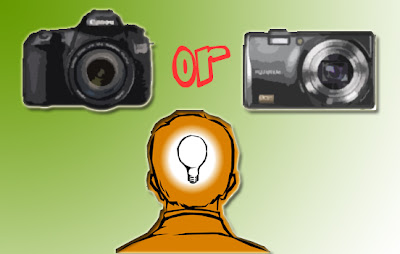A new model is launch! The Panasonic Lumix GH2 is the newest Macro Four Third System camera. As its name suggests, Panasonic Lumix GH2 is the replacement model of GH1. We can still find significant differences, and we shall look at these differences now.
The GH2 is a 16 Mega Pixels camera which allows you to print big big size!
The material used for GH2 is slightly different - it is less "smooth" than GH1, giving it a more "rugged" feel
The camera mode dial in the camera’s hand grip has been moved back, something which benefits control.
Although the Panasonic Lumix GH2’s body is almost identical to the GH1, the hand placement is a bit different. The hand grip is neatly covered with rubber and allows for the GH2 to sit in the hand perfectly. The material is more refined and has a professional look. A beginner will be able to use it immediately.
The Panasonic Lumix GH2's 3.0-inch touch screen LCD screen that rotates up to 270 degrees.
LCD viewfinder or Live viewfinder with 17.5mm eye point and diopter adjustment, and 100% frame coverage. Of course, it's not much of a surprise that the LCD screen can rotate for the ease of taking self-portrait photos but I'm still loving it :) 'Cause it's a TOUCH SCREEN LCD! :)
What GH2 has that other cameras don't is its super fast Auto Focus. Panasonic boast it's AF as "Light Speed AF" so I guess you have the idea of how fast the AF is.
Did I mention that it has FULL HD video recording as well? Yup, following the trend of movie making, our GH2 is able to capture FULL HD video. So if you want to be the next Steven Spielberg, your dream is not too far at all :)
Currently GH2 is on sale now at $1599 (14 - 42 mm lens) & $2399 (14 - 140mm lens)
Here are the specifications:
Image Sensor Size | 17.3mm x 13.0mm |
Lens Mount | Micro Four-thirds |
Image Sensor Type | Live MOS Sensor |
Camera Effective Pixels | 16.05 Mega Pixels |
Recording File Format | Still Image: JPEG(DCF, Exif 2.3), RAW, DPOF compatible MPO (When attaching 3D lens in Micro Four Thirds standard) / Motion Image: AVCHD / QuickTime Motion JPEG |
Image Quality | RAW, RAW+Fine, RAW+Standard, Fine, Standard, MPO+Fine, MPO+Standard (with 3D lens in Micro Four Thirds standard |
ISO sensitivity (Standard Output Sensitivity) | Auto / Intelligent ISO / 160 / 200 / 250 / 320 / 400 / 400 / 500/ 640 / 800 / 1000 / 1250 / 1600 / 2000 / 2500 / 3200 / 4000 / 5000 / 6400 / 8000 / 10000 / 12800 |
Light metering system | 144-zone multi-pattern sensing system |
Light metering mode | Intelligent Multiple / Center Weighted / Spot |
Exposure compensation | 1/3EV Step ±5EV |
Shutter speed | Still Images: 1/4000 ~ 60 and Bulb (up to approx. 2 minutes) |
Still Image SCN mode | Portrait (Normal/Soft Skin/Outdoor/Indoor/Creative) / Scenery (Normal/Nature/Architecture/Creative) / Close-up (Flower/Food/Objects/Creative) / SCN (Peripheral Defocus/Night Portrait/Night Scenery/Sunset/Party/Sports/Baby 1,2/Pet) |
Movie SCN mode | Portrait (Normal/Soft Skin/Outdoor/Indoor/Creative) / Scenery (Normal/Nature/Architecture/Creative) / Close-up (Flower/Food/Objects/Creative) / SCN (Peripheral Defocus/Night Portrait/Night Scenery/Sunset/Party/Sports/Baby 1,2/Pet) / (Activated by selecting Still Image SCN mode then pressing Movie Button. Still Image SCN modes without corresponding Movie SCN mode is recorded in mode suitable for the recording situation.) |
LCD Type | 3.0” TFT LCD with Touch Panel |
Dimensions (W x H x D) | 124 x 89.6 x 75.8mm (excluding protrusions) |
Weight | Approx.609g / 21.48 oz (SD card, Battery, 14-42mm lens included) / Approx. 904g / 31.88 oz (SD card, Battery, 14-140mm lens included) / Approx. 392g / 13.82 oz (Body only |
Battery life (CIPA standard) | Approx. 330 images (LCD), Approx. 340 images (LVF) with H-FS014042 / Approx. 320 images (LCD), Approx. 330 images (LVF) with H-VS014140 |


